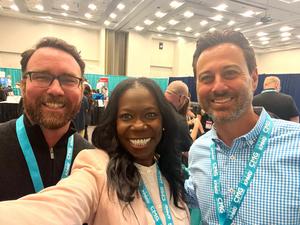One group of professionals who have moved seamlessly into the new normal created by Covid-19 are instructional designers.
They are specialists who create educational programs and online courses for institutions, organizations and corporations. That could include employee training courses, K-12 education plans and instruction for customers or stakeholders. In essence, when an organization needs to train or teach something, an instructional designer plans and designs the most compelling way to make that happen, said Suzanne Ensmann, an assistant professor of education at The University of Tampa.
“If you’re in a hospital facility, you need to train all of your employees about how you’ll approach your patients, and the same is true in the corporate world. They need training, too,” Ensmann said. “You can train them one at a time, but you don’t have time for that. That’s not as effective as creating digital instruction that’s going to do it more rapidly.”
That digital focus has never been more important than it is right now, she added.
“For our field, Covid-19 was a seamless transition. We can create every kind of instruction; it doesn’t have to be digital. But when it comes to digital, our students are already prepared,” Ensmann said.
Natasha Rabsatt, a 2017 graduate of UT’s instructional design and technology program, is a case in point. She decided to pursue her master’s degree in instructional design after serving in the U.S. Army, where she focused on counterterrorism and intelligence. In that work, she had to create a lot of training materials.
“I loved creating opportunities to empower people through learning, and I wanted to do that more in the rest of my career,” said Rabsatt, now a Tampa-based senior instructional designer at Amgen. “I was really interested in seeing how I could apply instructional design to different types of problem sets and in the corporate sector. It doesn’t matter what the problem set is; you can plug into a company and create opportunities for learning and success while you’re applying science and technology.”
Instructing in virtual environments
The technology component is what matters most now, in a world that went virtual, virtually overnight. At UT, Rabsatt learned how to create e-learning courses, to use mobile technology in instruction and to design interactive learning experiences. As a result, she said she has yet to encounter a situation in her career that she wasn’t prepared for — even a global pandemic.
“This program is extremely relevant today, especially considering the pandemic,” Rabsatt said. “In some cases, the types of services a company provides can be significantly altered by not being able to train people. Because we are able to work with a lot of these virtual technologies and still apply the science of learning and best practices, it makes us really valuable.”
Enilda Romero-Hall, UT graduate coordinator for the instructional design program and an associate professor of education, agreed that teaching online is not just putting content in an online repository. “There is so much more to the experience,” she said. “So I think there is a huge opportunity there for instructional designers.”
The number of students who see this opportunity has increased steadily since the program launched in 2012 Romero-Hall said. Students have come to instructional design from a variety of careers. Some have military experience. Some are career educators. Some come from business or financial backgrounds. And roughly 95% of them are looking to instructional design as a career change.
“I have seen learners who come from completely different backgrounds — a math background, a music background, a K-12 background. When they graduate, I’ve seen an increase in the number of students who go into corporate America, who work for banks or other large corporations, for the healthcare industry, insurance companies,” Romero-Hall said.
The U.S. Bureau of Labor Statistics anticipates that job growth for instructional coordinators will be in the area of 11% through 2026 as school districts aim for improved graduation rates and test scores. This is somewhat faster than average for all occupations. According to the U.S. Bureau of Labor Statistics, in 2019 the median annual salary for instructional coordinators was $66,290, and those in the top 10% earned more than $103,790.
Corporate and entrepreneurial paths
Some graduates have started their own consulting firms focused on instructional design. Others have taken jobs at major companies, such as Amazon. As more students come into the program in the midst of a new and largely virtual reality, Romero-Hall said she hopes they will go on to help organizations manage the shift.
“Companies no longer have eight-hour training sessions. Education and training are shifting to an online format in which employees can access it whether it’s on their computer at home or their computer in their work environment,” Romero-Hall explained. “So they’re shifting to creating engaging interactive instruction, and that’s an area where instructional designers play a major role.”
Gül Sahin is experiencing that shift firsthand.
Originally from Turkey, Sahin began her professional career as an engineer, but she was always interested in the educational process — not necessarily teaching but designing what she was going to teach to achieve maximum impact.
“My cousins would come to me when they were having trouble with a topic, and I would try to make the topic very interesting for them,” she recalled. “After we’d work through the topic, they would come to me and tell me they got the highest grade in the class.”
In her role as an engineer, part of her job was to conduct gap analyses, determining what employees were struggling with and then creating training programs to help them get better, she said.
When she found the UT program, it seemed like a perfect way to strengthen those nascent skills. “I said, ‘Yes, this is what my career needs to be.’ I wanted to be able to design and develop that training,” Sahin said.
In the program, she learned the theory and science behind what helps people learn, but also the technology that can facilitate that education, including programs such as Camtasia and Adobe Captivate. When she graduated in May 2017, Sahin had a complete portfolio, an internship at Ultimate Medical Academy under her belt and the opportunity to turn that internship into a contract job. By December 2017, she had joined Citibank in Tampa full time, designing and building corporate trainings for policies and procedures.
“If anybody wants to be an instructional designer, the program really prepares you for that,” Sahin said. “Once you graduate, you don’t have the anxiety of wondering what you’re going to do because you already have the experience. You’ve already worked as an intern. You’ve finished your portfolio, and you are really ready to go.”
Learn more about the M.S. in Instructional Design and Technology program at The University of Tampa. For additional information, visit www.ut.edu/gradinfo, email grad@ut.edu or call (813) 258-7409.
Mary Johnson is a freelance writer for The Business Journals Content Studio.





